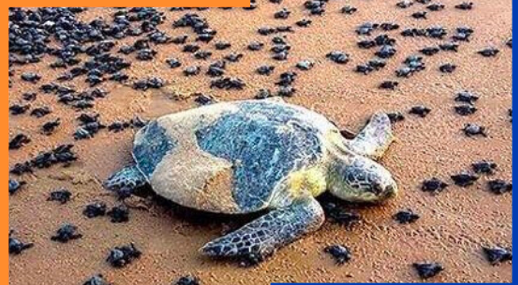Olive ridley turtles are best known for their synchronized nesting. Females return to the same beach from where they hatched, to lay their eggs. They lay their eggs in conical nests dug using their hind flippers, which is a little over a foot deep. In the Indian Ocean, most Olive Ridleys nest in two or three large groups near Gahirmatha in Odisha. The coast of Odisha in India is one the largest mass nesting site for the olive ridley. Apart from Gahirmatha, two other mass nesting beaches have been located, which are on the mouth of rivers Rushikulya and Devi. The spectacular site of mass congregation of olive ridley sea turtles for nesting enthrals both the scientists and the nature lovers all over the world. Olive ridley sea turtles migrate in huge numbers from the beginning of November, every year, for nesting along the coast of Odisha.
According to the Odisha Wildlife Organisation OWO), nearly 50 per cent of the world’s population of these rare turtles come to Odisha’s coast for nesting. Watching turtle nesting is amazing. Praveen Kaswan IFS narrate his experience to IndSamachar. “In such times the coasts are protected by staff. The turtles arrive in hundreds and thousands on the coast. They perfectly synchronize their movement with each other after swimming thousands of kilometres.” According to the Forest Department, over 2,78,502 mother turtles became a part of the day-time nesting activity. Over 72,142 Olive Ridleys have arrived at the beach to dig nests and lay eggs, since Tuesday morning and since the beginning of this year over 8 lakh Olive Ridley turtles have laid over 6 crore eggs so far.
On an average, each nest contains around 100 eggs. The incubation period is around 45 days. After that the mother start laying eggs. The eggs appear to resemble a soft wet ball. On average 80-100 eggs will be laid. This process is far from being easy for the mother turtle. One can often see the mother turtle cry in pain during this process. The mother turtle covers the hole with sand carefully and also dresses the area surrounding the nest to keep is discreet to predators. She retreats to the waters after this arduous process. This mass nesting is a strategy to protect them from predators like snakes, coyotes, feral dogs etc. Another way to distribute the threat and the scope of highest possible survival rate in their hatchlings. After 45 days the hatchlings surface and make their way to the serenading ocean.
With the lockdown, various parts of the globe have reported lesser pollution and nature thriving. Lesser contaminants being pumped into the oceans have boosted marine life. This lockdown has sure given Mother Nature a chance to recoup and reset the clock. These are lessons we should be taking home.
Author – Parveen Kaswan , IFS
Published as per His Tweets
Twitter – @ParveenKaswan
Instagram – parveen_kaswan




























 WhatsApp us
WhatsApp us
Pingback: 1688upx.com
Pingback: สมัคร LSM99